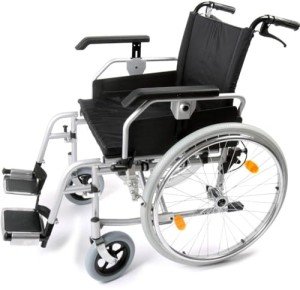Bariatric Wheelchair Seat Width
Seat Width
Having the right seat width is very important to wheelchair users who spend longer periods in their chairs. Too narrow a seat will cause pressure on the hips and thighs which could result in sores or pressure points. Having too large a seat can also make it tough for the user to reach the hand rims to move themselves or maneuver in small spaces.

To determine the proper seat width an individual would rest on a chair typically and have their measurement taken across their lap at the best point which is usually their hips. A wheelchair determining tape can be used to determine this, but a backyard stick is chosen as it avoids people from wrapping the tape around their hips which would offer an unreliable result.
The standard wheelchair seat width is 16" (narrow adult), 18" (basic grownup), and 20" (wide grownup). For bariatric clients, a 24" seat is readily available. This heavy-duty additional broad bariatric wheelchair from Medline features swing-away footrests, a carbon steel frame with rust- and chip-resistant chrome plating, and easy-to-clean vinyl upholstery. bariatric mobility equipment has a weight capacity of 500 pounds.
Seat Depth
Traditionally, the seat depth of a bariatric wheelchair was added 2" to the measurement taken at the user's widest point (generally their hips). This was indicated to accommodate additional layers of clothing that may be used during winter. However, this practice is ending up being less common as wheelchair users are able to spend more time indoors and are not using long coats. This makes the seat depth of a chair lesser when selecting a bariatric wheelchair. However, it is still important to pick an alternative that offers adequate support for larger users.
The Medline folding extra broad bariatric manual wheelchair includes a comfortable 24" seat width and a heavy-duty slide tube silver vein frame. It also has an adjustable axle and tool-free elevating legrests.
Seat Height
When it comes to determining the right wheelchair seat width you need to constantly measure from the user's largest point which is generally their hips. You will also require to think about whether the user is going to be wearing a winter coat as this might include 2" to the width needed.
When a wheelchair remains in use it need to only be run on level surface areas with the wheel locks totally engaged. This is to prevent the chair from being able to move inclines that are 10 degrees or greater. It is likewise crucial to keep in mind that any activity that might move the center of gravity in the chair need to be done with care. This includes grabbing products that need the person to lean out of their seat or trying to stand from it.
Whenever you have the chair in use it is suggested that you frequently inspect it for damage and lube any locations that are deemed required. For This Web site , the casters need to be lubricated by eliminating the caster fork and utilizing a multi-purpose grease to use to the caster stem bearings. Similarly, the foot plates can be changed by loosening the bolt and then moving them to the preferred position. This permits the feet to sit conveniently on the footplate and prevents any pressure points from forming. This can be extremely uneasy for the user and if left ignored, can lead to pressure sores.
Weight Capacity
Bariatric wheelchairs are developed to support more weight than basic wheelchairs. This makes them stronger and better geared up to handle falls. They are also generally larger and broader, making them less maneuverable in tight areas than standard wheelchairs. They need lorries with special ramps and lifts to load them, along with chauffeurs who know how to best transport them from one location to the next.
When picking a wheelchair, consider its weight capacity as it will be the primary determining consider whether it will accommodate your traveler's needs. The weight capacity of the chair is often noted as a static load, implying that it indicates the quantity of weight the chair can easily hold while stalling. However, some manufacturers likewise list an active load that is based upon a drop test and can simulate the result of somebody sitting down in the chair. This might be a more trusted measurement of the weight limit, depending on your requirements.
If you plan to perform activities that shift your center of mass in the seat (such as grabbing items), make sure to have front casters pointed in a forward instructions and wheel locks engaged so the chair will not tip over. Likewise, inspect that casters are oiled routinely to avoid excessive wear and abrasions. The lubrication treatment includes removing the fork, separating the caster from the wheel, and greasing the caster stem bearings with premium multi-purpose grease.
